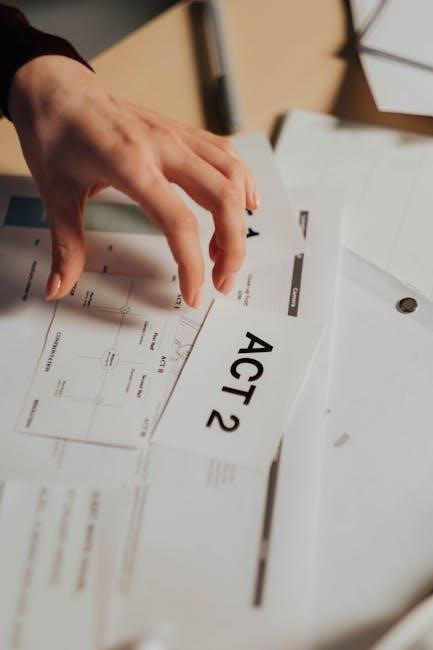Guided reading is a structured approach to teaching reading, focusing on small group instruction; It helps Key Stage 2 pupils develop reading skills and confidence through targeted support․
Definition and Purpose of Guided Reading
Guided reading is a teacher-led instructional approach where small groups of students read selected texts while receiving scaffolding and support․ Its primary purpose is to improve reading comprehension, fluency, and confidence․ Teachers assess students’ reading levels to match texts appropriately, ensuring challenge and progress․ The goal is to bridge the gap between independent and guided reading, fostering independence․ Guided reading sessions involve pre-reading discussions, reading aloud, and post-reading reflections, encouraging deeper understanding and critical thinking․ This method is particularly beneficial for students who need additional support or enrichment, helping them develop reading strategies and a love for reading․
Importance of Guided Reading in Key Stage 2
Guided reading plays a vital role in Key Stage 2 by fostering reading development and literacy skills․ It bridges the gap between teacher-led instruction and independent reading, helping students build confidence and fluency․ By engaging with challenging texts, pupils enhance their comprehension and critical thinking abilities․ Guided reading also allows teachers to cater to diverse learning needs, providing targeted support and feedback․ This approach encourages active participation, fostering a deeper understanding of texts and promoting a lifelong love for reading․ Regular guided reading sessions ensure students progress at their own pace, preparing them for more complex reading tasks as they advance academically․

Structure of a Guided Reading Session
A guided reading session in Key Stage 2 typically includes introduction/setup, reading, and follow-up/assessment activities to ensure comprehension and skill development in students․
The introduction and setup phase of a guided reading session in Key Stage 2 is crucial for engaging students․ Teachers begin by establishing a clear purpose, often through a brief discussion or question to activate prior knowledge․ This helps students connect with the text and sets expectations․ The teacher may introduce vocabulary or concepts that are central to the passage, ensuring all pupils have a foundational understanding․ Additionally, the reading objective is shared, focusing on skills like comprehension, fluency, or inference․ This phase also involves organizing students into small groups and distributing materials, ensuring everyone is prepared to participate actively․ A well-structured introduction ensures a smooth transition into the reading activity, maximizing learning opportunities for all students․ This setup is designed to create a focused and supportive environment, fostering engagement and readiness for the reading task ahead․
Reading and Discussion
During the reading phase, students independently read a selected text, either silently or aloud, while the teacher observes and takes notes on their reading behaviors․ The discussion that follows is a critical component, allowing pupils to share insights and deepen their understanding․ The teacher facilitates this by asking open-ended questions that encourage critical thinking and promote comprehension strategies․ Students are also guided to use text-based evidence to support their responses, fostering analytical skills․ This interactive dialogue helps identify areas where pupils may need additional support and enables the teacher to model effective reading practices․ The discussion also provides opportunities for students to reflect on their own reading processes and strategies, reinforcing their learning and confidence․
- Focus on comprehension and vocabulary development․
- Encourage pupils to share their interpretations and insights․
- Use open-ended questions to promote deeper thinking․
- Provide feedback and guidance to support learning․
Follow-Up and Assessment
Following the reading activity, the teacher conducts a focused assessment to evaluate pupils’ understanding and progress․ This involves reviewing their responses during discussion, observing reading behaviors, and identifying areas of strength and challenge․ Feedback is provided to guide further learning, with specific examples from the text to reinforce comprehension strategies․ Teachers also use this opportunity to assess fluency, accuracy, and vocabulary use․ Additionally, formative assessments are implemented to track pupil progress over time, informing future lesson planning and ensuring targeted support․ This step ensures that each pupil’s needs are met and that the instruction is tailored to their development․ Regular follow-up activities, such as review exercises or reading journals, further consolidate learning and reinforce skills․
- Evaluate pupil understanding through observation and discussion․
- Provide constructive feedback to guide improvement․
- Use formative assessments to track progress and inform instruction․
- Consolidate learning through follow-up activities․

Benefits of Guided Reading
Guided reading fosters improved reading development by enhancing comprehension, fluency, and confidence․ It equips pupils with essential skills for independent reading and lifelong learning․
- Improves comprehension through focused discussions and text analysis․
- Develops fluency by practicing reading aloud with support․
- Builds confidence as pupils master new reading challenges․
Improved Reading Comprehension
Guided reading significantly enhances pupils’ ability to understand and interpret texts․ By engaging in focused discussions, students develop skills to extract meaning, make inferences, and analyze characters or themes․ Teachers model strategies like questioning, summarizing, and predicting, helping pupils apply these techniques independently․ Regular exposure to diverse texts builds vocabulary and familiarity with different genres, further improving comprehension․ Small group settings allow for tailored support, ensuring pupils grasp complex ideas and develop critical thinking․ This structured approach fosters a deeper understanding of texts, preparing pupils for independent reading challenges and nurturing a lifelong love for reading․
Enhanced Fluency and Accuracy
Guided reading plays a crucial role in improving pupils’ fluency and accuracy․ Through repeated exposure to texts and targeted teacher support, students develop the ability to read with greater precision and rhythm․ Teachers model fluent reading, demonstrating proper intonation, pacing, and expression, which pupils emulate during practice․ Small group settings allow for immediate feedback, helping students correct misread words and refine their delivery․ Regular practice with leveled texts ensures that pupils progress at their own pace, building confidence and reducing hesitations․ Over time, this structured approach leads to smoother, more natural reading, allowing students to focus on comprehension rather than decoding challenges․
Increased Student Confidence
Guided reading fosters increased student confidence by providing a supportive environment where pupils feel comfortable taking risks․ Teachers offer individualized feedback, helping students overcome challenges and celebrate successes․ Regular opportunities to read aloud and discuss texts build pupils’ self-assurance in their abilities․ The structured, small-group setting ensures that each student receives attention, reducing anxiety and promoting a growth mindset․ Over time, as pupils see improvement in their reading skills, their confidence grows, enabling them to tackle more complex texts independently․ This empowerment extends beyond reading, fostering a positive attitude toward learning and academic challenges․
Key Factors for Effective Guided Reading
Effective guided reading requires skilled teacher facilitation, engaging texts, and a supportive environment․ It thrives on active participation, clear goals, and meaningful feedback․
Teacher Guidance and Support
Teacher guidance and support are pivotal in guided reading sessions․ Educators play a crucial role in preparing engaging texts, setting clear objectives, and creating a supportive environment․ They must observe students’ reading behaviors, offer timely feedback, and scaffold learning to address challenges․ Effective teachers actively listen, ask open-ended questions, and encourage deeper comprehension․ They also adapt instruction to meet diverse needs, ensuring all pupils participate meaningfully․ The teacher’s ability to balance guidance with independence fosters confidence and fluency․ Regular assessment helps monitor progress and inform future lessons․ By providing structured yet flexible support, teachers empower students to become proficient readers․ This dynamic interaction between teacher and students is essential for maximizing the benefits of guided reading in Key Stage 2․
Student Engagement and Participation
Student engagement and participation are vital for the success of guided reading in Key Stage 2․ Encouraging active involvement ensures pupils are motivated and focused․ Teachers can achieve this by selecting texts that match students’ interests and reading levels, fostering a sense of ownership․ Interactive activities, such as discussions and role-playing, enhance comprehension and retention․ Positive reinforcement and constructive feedback also play a key role in building confidence․ When students feel valued and supported, they are more likely to contribute meaningfully․ This collaborative approach not only improves reading skills but also develops critical thinking and communication abilities․ By making learning enjoyable and inclusive, teachers ensure that all students remain engaged and committed to their reading journey․
Differentiated Instruction
Differentiated instruction is a cornerstone of effective guided reading in Key Stage 2․ It involves tailoring teaching methods to meet the diverse needs of students, ensuring that each pupil receives appropriate support․ By assessing individual reading levels and learning needs, teachers can create targeted activities that cater to varying abilities․ This approach fosters inclusivity and ensures no student feels left behind․ Differentiated instruction also encourages personalized learning, allowing students to progress at their own pace․ Teachers can use tiered tasks, leveled texts, or small group work to differentiate instruction․ Regular observation and formative assessments help identify areas where students may need additional support or challenges․ By adapting instruction to suit individual needs, teachers create a more dynamic and effective learning environment․

Implementing Guided Reading in the Classroom
Implementing guided reading in Key Stage 2 involves creating a structured, engaging environment․ Teachers prepare materials, lead discussions, and provide feedback, fostering active participation and comprehension․
Preparing for Guided Reading Sessions
Preparing for guided reading sessions involves selecting appropriate texts, planning discussion points, and setting clear objectives․ Teachers choose books that match students’ reading levels and interests, ensuring engagement․ They also identify key vocabulary, comprehension questions, and teaching points to focus on during the session․ Organizing materials, such as highlighting important passages or creating graphic organizers, supports student understanding․ Additionally, establishing a routine helps students transition smoothly into the activity․ This preparation ensures that each session is purposeful and aligned with learning goals, maximizing the benefits for all pupils․ Effective planning fosters a productive and meaningful guided reading experience․
During the Reading Activity
During the reading activity, teachers provide active support to students, ensuring they understand the text․ This involves prompting, questioning, and scaffolding to guide comprehension․ Teachers may pause reading to discuss key points, clarify vocabulary, or address misconceptions․ Students are encouraged to read aloud or silently, depending on the group’s needs․ The teacher observes students’ engagement and provides immediate feedback, helping them apply reading strategies like summarizing, predicting, or visualizing․ This interactive approach fosters a collaborative learning environment, allowing students to build confidence and fluency while deepening their understanding of the text․ The goal is to create a supportive space where students feel comfortable taking risks and developing their reading skills․
Assessment and Feedback
Assessment and feedback are critical components of guided reading in Key Stage 2․ Teachers continuously observe students during reading activities, noting their fluency, accuracy, and comprehension․ Informal assessments, such as running records or reading journals, help track progress and identify areas for support․ Feedback is provided immediately, focusing on specific strengths and areas for improvement․ Students are encouraged to reflect on their own learning, setting goals for future reading sessions․ This ongoing process ensures personalized instruction and helps build students’ confidence and skills․ Regular feedback also allows teachers to adjust instruction, ensuring all learners are challenged and supported appropriately․ By integrating assessment and feedback, teachers can effectively monitor growth and foster a love of reading in their students․

Common Challenges and Solutions
Managing diverse reading levels and maintaining focus are common challenges․ Differentiated instruction, engaging texts, and structured activities help address these issues effectively, promoting productive learning environments․
Managing Different Reading Levels
Guided reading in Key Stage 2 often involves pupils with varied reading abilities․ To manage this, teachers can group students by skill level, allowing tailored instruction․ Using leveled texts ensures each group works within their reading range․ Additionally, incorporating scaffolding techniques helps bridge gaps for struggling readers, while advanced students can engage with more complex materials․ Regular assessments and flexible grouping enable teachers to adjust instruction dynamically, ensuring all students receive appropriate support․ This approach fosters an inclusive environment where every child can progress at their own pace, building confidence and fluency in their reading journey․
Keeping Students Focused
Keeping students focused during guided reading requires clear expectations and engaging strategies․ Teachers can establish routines, such as setting clear objectives and using visual timers, to help pupils stay on task․ Incorporating interactive activities, like discussions or think-pair-share, encourages active participation․ Providing texts that align with students’ interests or current topics also boosts engagement․ Additionally, movement breaks and positive reinforcement can help maintain concentration․ Structured sessions with defined roles, such as leader or summarizer, can further enhance focus․ By creating a supportive and purposeful environment, teachers can ensure students remain attentive and motivated throughout the guided reading session․

Resources for Guided Reading
Guided reading resources include high-quality texts, leveled books, and digital tools․ Popular series like Oxford Reading Tree and online platforms like Reading A-Z support engaging lessons․
Recommended Books for Key Stage 2
Key Stage 2 guided reading often features books that blend engaging stories with challenging vocabulary and themes․ Popular choices include The Lion, the Witch, and the Wardrobe by C․S․ Lewis, Charlotte’s Web by E․B․ White, and The Magic Tree House series by Mary Pope Osborne․ These texts are rich in dialogue and moral lessons, fostering comprehension and discussion․ Non-fiction books like The Guinness World Records or National Geographic Kids also captivate students, linking reading to real-world knowledge․ Poetry anthologies, such as Now We Are Six by A․A․ Milne, encourage fluency and creativity․ Graphic novels like Zita the Spacegirl by Ben Hatke are equally effective, making complex stories accessible․ These diverse texts cater to varied interests, promoting a love for reading and learning․
Online Tools and Materials
Several online tools and materials support guided reading in Key Stage 2, enhancing both teaching and student engagement․ Platforms like Reading A-Z offer leveled books and resources for differentiated instruction․ Teach Your Monster to Read is an interactive game that helps students develop phonics skills․ Websites such as Bug Club provide guided reading books with quizzes to assess comprehension․ Additionally, tools like DK Find Out! and National Geographic Kids offer engaging articles for reading practice․ Many schools use online libraries like MyOn or Accelerated Reader to track reading progress․ These resources make guided reading more dynamic and accessible, catering to diverse learning needs and preferences․
Guided reading is a highly effective approach to teaching reading in Key Stage 2, fostering a deeper understanding of texts and improving reading fluency․ By providing targeted support and encouraging active participation, it helps students build confidence and develop essential reading skills․ The structured sessions allow teachers to address individual needs and monitor progress effectively․ With its focus on comprehension, vocabulary, and critical thinking, guided reading prepares pupils for more complex texts as they progress in their educational journey․ Ultimately, it is a valuable tool for creating lifelong readers who can engage meaningfully with a wide range of materials․ By integrating both traditional and digital resources, guided reading remains a cornerstone of modern reading instruction․